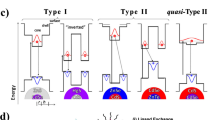Abstract
Porphyrins are a class of conjugated molecules that structurally and functionally resemble natural photosynthetic and enzymatic chromophores. Crystalline solids self-assembled from anionic and cationic porphyrins yield a new class of multifunctional optoelectronic micro- and nanomaterials. In this article, we provide details on the concept of binary ionic self-assembly (ISA) and ionized forms of porphyrins, as well as formation of hierarchical structures, including nanotubes, rods and ribbons, sheets, and three-dimensional clover-like shapes, spheres, and sheaf-like structures. We summarize key physical properties from ultraviolet–visible characterizations of J-aggregate, exciton delocalization and extended π–π stacking, and related electronic and light-harvesting properties of the structures. Depending on the molecular subunits, the functionalities of the ISA materials are altered. These ISA nanostructures possess attractive light-harvesting and charge- and energy-transport functionalities and allow access to a novel class of nanomaterials with potential for applications in sensors, photovoltaics, photocatalysis, and solar power.




Similar content being viewed by others
References
C.M. Drain, A. Varotto, I. Radivojevic, Chem. Rev. 109, 1630 (2009).
Y. Chen, A. Li, Z. Huang, L. Wang, F. Kang, Nanomaterials 6, 51 (2016).
E. Shevchenko, D. Talapin, N. Kotov, S. O’Brien, C. Murray, Nature 439, 55 (2006).
C. Zhang, P. Chen, H. Dong, Y. Zhen, M. Liu, W. Hu, Adv. Mater. 27, 5379 (2015).
H. Ju, X. Zhang, J. Wang, in NanoBiosensing Principles, Development and Application, H. Ju, X. Zhang, J. Wang, Eds. (Springer, New York, 2011), pp. 111–146.
T. Hasobe, H. Sakai, in Chemical Science of π-Electron Systems, T. Akasaka, A. Osuka, S. Fukuzumi, H. Kandori, Y. Aso, Eds. (Springer, Tokyo, 2015), pp. 475–491.
Z. Wang, Z. Li, C.J. Medforth, J.A. Shelnutt. J. Am. Chem. Soc. 129, 2440 (2007).
S. Hiroto, Y. Miyake, H. Shinokubo, Chem. Rev. 117, 2910 (2017).
J. Wang, Y. Zhong, X. Wang, W. Yang, F. Bai, B. Zhang, L. Alarid, K. Bian, H. Fan, Nano Lett. 17, 6916 (2017).
J. Wang, Y. Zhong, L. Wang, N. Zhang, R. Cao, K. Bian, L. Alarid, R.E. Haddad, F. Bai, H. Fan, Nano Lett. 16, 6523 (2016).
Y. Zhong, J. Wang, R. Zhang, W. Wei, H. Wang, X. Lü, F. Bai, H. Wu, R. Haddad, H. Fan, Nano Lett. 14, 7175 (2014).
P.L. Marek, in Biomimetic Dye Aggregate Solar Cells, P.L. Marek, Ed. (Springer International, New York, 2013), pp. 27–90.
A. Pichon, Nat. Chem. 2, 611 (2010).
L.G. De, A. Romeo, V. Villari, N. Micali, I. Foltran, E. Foresti, I.G. Lesci, N. Roveri, T. Zuccheri, L.M. Scolaro, J. Am. Chem. Soc. 131, 6920 (2009).
K.W. Hipps, U. Mazur, J.R. Eskelsen, M. Adinehnia, in Handbook of Porphyrin Science, K.W. Hipps, U. Mazur, J.R. Eskelsen, M. Adinehnia, Eds. (World Scientific, Singapore, 2016), pp. 69–103.
Z. Wang, K. Ho, C. Medforth, J. Shelnutt, Adv. Mater 18, 2557 (2006).
Z. Wang, C. Medforth, J. Shelnutt, J. Am. Chem. Soc. 126, 15954 (2004)
K. Martin, Z. Wang, T. Busani, R. Garcia, Z. Chen, Y. Jiang, Y. Song, J. Jacobsen, T. Vu, N. Schore, B. Swartzentruber, C. Medforth, J. Shelnutt, J. Am. Chem. Soc. 132, 8194 (2010).
Z. Wang, L. Lybarger, W.Wang, C. Medforth, J. Miller, J. Shelnutt, Nanotechnology 19, 395604 (2008).
Y. Tian, C. Beavers, T. Busani, K. Martin, J. Jacobsen, B. Mercado, B. Swartzentruber, F. van Swol, C. Medforth, J. Shelnutt, Nanoscale 4, 1695 (2012).
J. Shelnutt, Y. Tian, K. Martin, C. Medforth, in Handbook of Porphyrin Science, J. Shelnutt, Y. Tian, K. Martin, C. Medforth, Eds. (World Scientific, Singapore, 2013), pp. 227–277.
J. Shelnutt, C. Medforth, in Organic Nanomaterials: Synthesis, Characterization, and Device Applications, T. Torres, G. Bottari, Eds. (Wiley, Hoboken, NJ, 2013), pp. 103–130.
Z. Wang, C. Medforth, J. Shelnutt, J. Am. Chem. Soc. 126, 16720 (2004).
C. Medforth, Z. Wang, K. Martin, Y. Song, J. Jacobsen, J. Shelnutt, Chem. Commun. 47, 7261 (2009).
Y. Tian, K. Martin, J. Shelnutt, L. Evans, T. Busani, J. Miller, C. Medforth, J. Shelnutt, Chem. Commun. 47, 6069 (2011).
C.J. Medforth, F.B. van Swol, in Office of Scientific & Technical Information Technical Reports (Sandia National Laboratories, Albuquerque, NM, 2010), pp. 4–10.
Acknowledgements
Y.Z. acknowledges support from the National Natural Science Foundation of China (21802032), the Program for Changjiang Scholars, and the Innovative Research Team in University, Henan Province (No. PCS IRT_15R18).
Author information
Authors and Affiliations
Corresponding author
Rights and permissions
About this article
Cite this article
Zhong, Y., Wang, J. & Tian, Y. Binary ionic porphyrin self-assembly: Structures, and electronic and light-harvesting properties. MRS Bulletin 44, 183–188 (2019). https://doi.org/10.1557/mrs.2019.40
Published:
Issue Date:
DOI: https://doi.org/10.1557/mrs.2019.40




